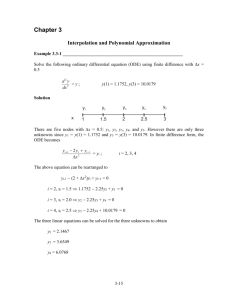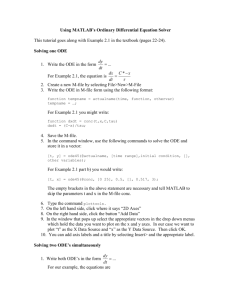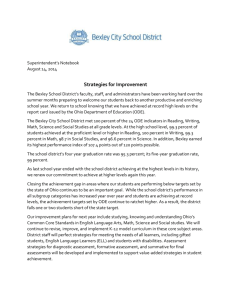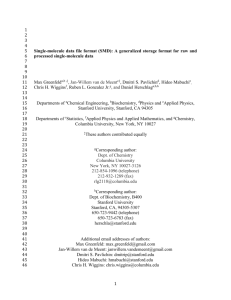ME 481 – H14 Name
advertisement
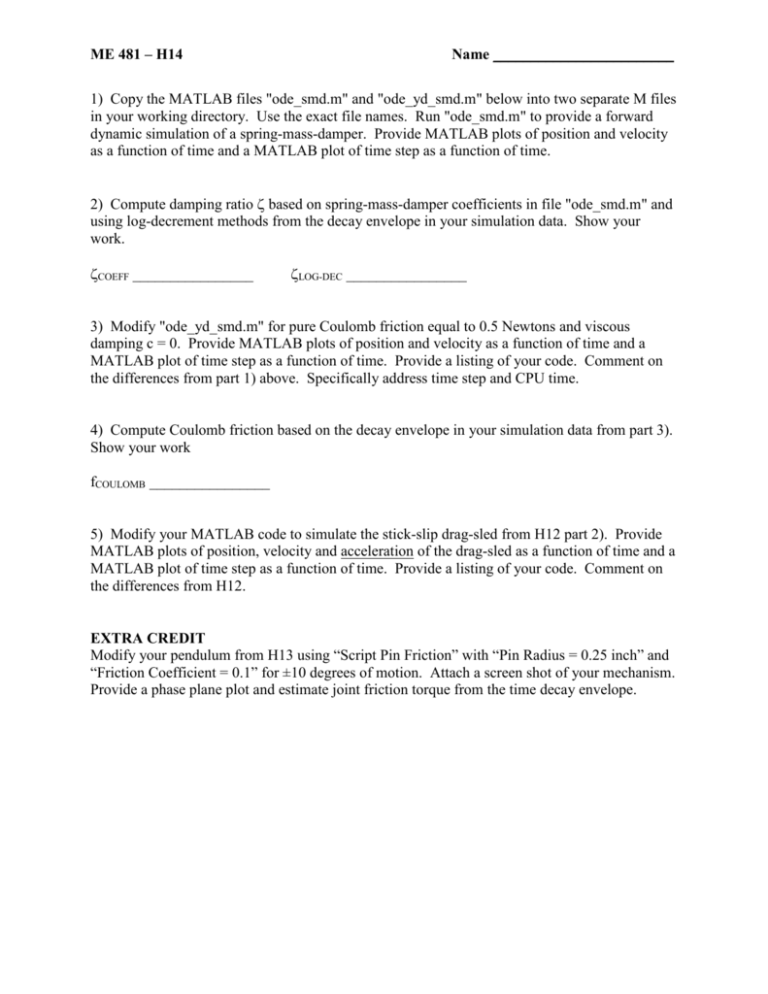
ME 481 – H14
Name ________________________
1) Copy the MATLAB files "ode_smd.m" and "ode_yd_smd.m" below into two separate M files
in your working directory. Use the exact file names. Run "ode_smd.m" to provide a forward
dynamic simulation of a spring-mass-damper. Provide MATLAB plots of position and velocity
as a function of time and a MATLAB plot of time step as a function of time.
2) Compute damping ratio based on spring-mass-damper coefficients in file "ode_smd.m" and
using log-decrement methods from the decay envelope in your simulation data. Show your
work.
COEFF ________________
LOG-DEC ________________
3) Modify "ode_yd_smd.m" for pure Coulomb friction equal to 0.5 Newtons and viscous
damping c = 0. Provide MATLAB plots of position and velocity as a function of time and a
MATLAB plot of time step as a function of time. Provide a listing of your code. Comment on
the differences from part 1) above. Specifically address time step and CPU time.
4) Compute Coulomb friction based on the decay envelope in your simulation data from part 3).
Show your work
fCOULOMB ________________
5) Modify your MATLAB code to simulate the stick-slip drag-sled from H12 part 2). Provide
MATLAB plots of position, velocity and acceleration of the drag-sled as a function of time and a
MATLAB plot of time step as a function of time. Provide a listing of your code. Comment on
the differences from H12.
EXTRA CREDIT
Modify your pendulum from H13 using “Script Pin Friction” with “Pin Radius = 0.25 inch” and
“Friction Coefficient = 0.1” for ±10 degrees of motion. Attach a screen shot of your mechanism.
Provide a phase plane plot and estimate joint friction torque from the time decay envelope.
ME 481 – H14
%
%
%
%
%
%
%
Name ________________________
ode_smd.m - example use of ODE solver for spring-mass-damper
HJSIII, 11.03.11
ODE coded in file ode_yd_smd.m
{y} = { x }
{ xd }
-
m*xdd + c*xd + k*x = Fext
{yd} = { xd } = [ 0
{ xdd }
[ -k/m
1
] {y}
-c/m ]
clear
global m
%
%
%
%
m
k
c
k
c
physical constants
x [m]
xd [m/sec]
xdd [m/sec^2]
= 1;
% mass [kg]
= 157.9;
% spring [N/m] - causes wn=2Hz
= 2;
% viscous [N.sec/m] - causes 4 sec exp decay
% initial conditions
y0 = [ 0.1 0 ]';
% free release
% time range
tspan = [ 0 4 ];
% measure CPU time
tic;
[ t, y ] = ode23( 'ode_yd_smd', tspan, y0 );
t_exe = toc
% time step
delta_t = 1000 * diff(t);
% units [msec]
delta_t = [ delta_t ; delta_t(end) ];
% repeat last value
n_time_steps = length(t)
ave_time_step = mean( delta_t )
% time domain results
figure( 1 )
subplot( 2, 2, 1 )
plot( t,y(:,1) )
xlabel( 'Time [sec]' )
ylabel( 'Position [m]' )
axis( [ 0 4 -0.1 0.1 ] )
subplot( 2, 2, 2 )
plot( t,y(:,2) )
xlabel( 'Time [sec]' )
ylabel( 'Velocity [m/sec]' )
axis( [ 0 4 -1.5 1.5 ] )
subplot( 2, 2, 3 )
plot( t,delta_t )
xlabel( 'Time [sec]' )
ylabel( 'Time step [msec]' )
% compute A(linear) over all t
n = length( t );
Y = y';
Ydot = [];
for j = 1:n,
tval = t(j);
yval = y(j,:)';
Ydot = [ Ydot ode_yd_smd( tval, yval ) ];
end
% compare linear model to actual model
A_smd = [ 0
1
;
-k/m -c/m ]
A_linear = Ydot * Y' * inv( Y * Y' )
% frequencies
ME 481 – H14
Name ________________________
[ modes, wn ] = eig( A_linear );
wn = diag( wn );
fn = imag(wn) /2 /pi
% bottom of ode_smd
++++++++++++++++++++++++++++++++++++++++++++++++++++++++++++++++++++++++++++++++++++++++
function yd = ode_yd_smd( t, y )
% spring-mass-damper
%
m*xddot + c*xdot + k*x = Fext
%
called by ode_smd.m
% HJSIII, 11.03.11
global m
k
c
% free motion
Fext = 0;
% individual terms
x = y(1);
xd = y(2);
xdd = ( -k*x -c*xd +Fext ) / m;
% return values
yd(1,1) = xd;
yd(2,1) = xdd;
% use linear ODE with constant coefficients
%Asmd = [ 0
1
;
%
-k/m -c/m ];
%yd = A * y;
% bottom of ode_yd_smd




